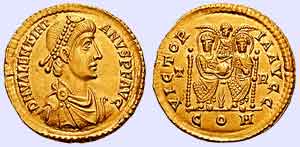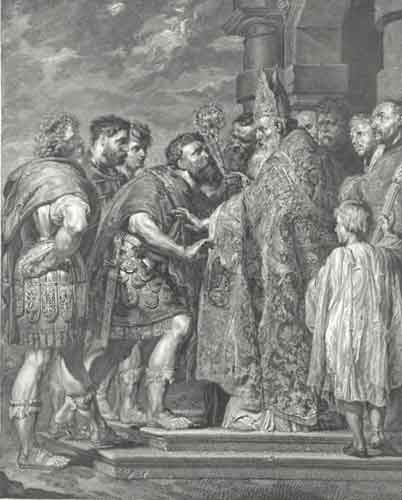|
|
On the reverse of this coin minted under Valentinian II, both Valentinian and Theodosius are depicted with halos, holding a globus cruciger. [] Theodosius oversaw the erection in 390 of the Egyptian obelisk from Karnak. As Imperial spoils, it still stands in the Hippodrome, the long racetrack that was the center of Constantinople's public life and scene of political turmoils. Re-erecting the monolith was a challenge for the technology that had been honed in siege engines (compare the 20th century arms race). The obelisk, still recognizably a solar symbol, was removed to Alexandria in the first flush of Christian triumphalism at mid-century, but then spent a generation lying at the docks while people figured how to ship it to Constantinople. (It was cracked in transit nevertheless.) The white marble base (illustration left) is entirely covered with bas-reliefs documenting the Imperial household and the engineering feat itself. Theodosius and the Imperial family are separated from the nobles among the spectators in the Imperial box with a cover over them as a mark of their status. The naturalism of the Roman tradition in such scenes is giving way to a conceptual art: the idea of order, decorum and respective ranking, expressed in serried ranks of faces, is beginning to oust the mere transitory details of this life, celebrated in pagan portraiture. Christianity had only just been appointed the new state religion. Nicene Christianity becomes the state religion In the 4th century, the Christian Church in the Roman Empire was wracked with controversy over the nature of the Trinity. In 325, the Council of Nicea had condemned the teachings of the theologian Arius: that the Son, or Word, who in Christian belief was incarnated as Jesus Christ, was a created being and inferior to God the Father, and that the Father and Son were of a similar substance (homoiousion in Greek) but not identical. The Council had formulated the Nicene Creed, which declared that God the Son (or Word) and God the Father were of the same substance (homoousion in Greek). The Council did not settle these controversies, and by the time of Theodosius' accession, there were still several different church factions that sought to impose their views on Christianity as a whole. While no mainstream churchmen within the Empire explicitly adhered to Arius or his teachings, there were those who still used the homoiousion formula, as well as those who attempted to bypass the debate by merely saying that Jesus was like (homoi in Greek) God the Father. All these non-Nicenes were frequently labeled as Arians (i.e., followers of Arius) by their opponents, though they would not have identified themselves as such. (For a succinct survey of the situation just before Theodosius' accession, see Failure of Empire, by Noel Lenski (U. of California Press, 2002, ISBN 0520233328) pp. 235-237). The Emperor Valens had favored the group who used the homoi formula; this theology was prominent in much of the East and had under the sons of Constantine the Great gained a foothold in the West. Theodosius, on the other hand, cleaved closely to the Nicene Creed: this was the line that predominated in the West and was held by the important Alexandrian church. Two days after Theodosius arrived in Constantinople, (November 24, 380), Theodosius expelled the non-Nicene bishop, Demophilus of Constantinople, and surrendered the churches of that city to Gregory Nazianzus, the leader of the small Nicene community there, an act which provoked rioting. Theodosius had just been baptized, by bishop Acholius of Thessalonica, during a severe illness, as was common in the early Christian world. In February he and Gratian published an edict that all their subjects should profess the faith of the bishops of Rome and Alexandria (i.e., the Nicene faith). Although much of the church hierarchy in the East had held non-Nicene positions in the decades leading up to Theodosius' accession, he managed to impose Nicene uniformity during his reign. Later Nicene writers took special glee in the ignominious death of Valens, the Arians' protector, and indeed his defeat probably damaged the standing of the Homoian faction. For the first part of his rule, Theodosius seems to have ignored the semi-official standing of the Christian bishops; in fact he had voiced his support for the preservation of temples or pagan statues as useful public buildings. Then, in a series of decrees called the Theodosian decrees he progressively declared that those pagan feasts that had not yet been rendered Christian ones were now to be workdays (in 389). In 391, he outlawed blood sacrifice and decreed "no one is to go to the sanctuaries, walk through the temples, or raise his eyes to statues created by the labor of man". The temples that were thus closed could be declared "abandoned" as Bishop Theophilus of Alexandria immediately noted in applying for permission to demolish a site and cover it with a Christian church, an act that must have received general sanction, for mithraea forming crypts of churches, and temples forming the foundations of 5th century churches appear throughout the former Roman Empire. Theodosius participated in actions by Christians against major pagan sites: the destruction of the gigantic Serapeum of Alexandria and its library by a mob in around 392, authorized by Theodosius (extirpium malum) and described in exultant detail by Christian propagandists, was only the most spectacular such occasion (see Peter Brown, The Rise of Western Christendom, 2003, p. 73-74). The destruction of the greatest temple in Alexandria gave encouragement to Christian vigilantism and mob action in other centers, often spurred on by the local bishops, as early hagiographies proudly relate. By decree in 391, Theodosius ended the subsidies that had still trickled to some remnants of Greco-Roman civic paganism too. The eternal fire in the Temple of Vesta in the Roman Forum was extinguished, and the Vestal Virgins were disbanded. Taking the auspices and practicing witchcraft were to be punished. Pagan members of the Senate in Rome appealed to him to restore the Altar of Victory in the Senate House; he refused. After the last Olympic Games in 393, Theodosius cancelled the much-diminished games, and the reckoning of dates by Olympiads soon came to an end. Now Theodosius portrayed himself on his coins holding the labarum.
Ambrose rebukes Theodosius, Peter Paul Rubens The apparent change of policy that resulted in the "Theodosian decrees" has often been credited to the increased influence of Ambrose, bishop of Milan. The personal piety of Theodosius cannot be assessed. It is worth noting that in 390 Ambrose had excommunicated Theodosius, who had recently ordered the massacre of several thousand inhabitants of Thessalonica, in response to the assassination of his military governor stationed in the city, and that Theodosius performed several months of public penance. The specifics of the decrees were superficially limited in scope, specific measures in response to various petitions and accusations from the increasingly militant Christians throughout his administration. In 391 or 392 he officially sanctioned the destruction of the most famous of the temples in the East, the Serapeum at Alexandria. Bands of monks and Christian officials had long been accustomed to take the law into their own hands and destroy various centers of pagan worship, but the destruction of the Serapeum seemed to confirm that such actions enjoyed the emperor's tacit approval at least, and served to encourage such action in the future. Theodosius had been effectively manipulated into sanctioning the destruction of the Serapeum by local officials who had essentially engineered the crisis there for this very purpose. Ambrose preached a panegyric at Theodosius' funeral.
The Theodosian women
Links De Imperatoribus Romanis, Theodosius I Preceded by: Gratian and Valentinian II Retrieved from "http://en.wikipedia.org"
 |
|
||||||||||||||

